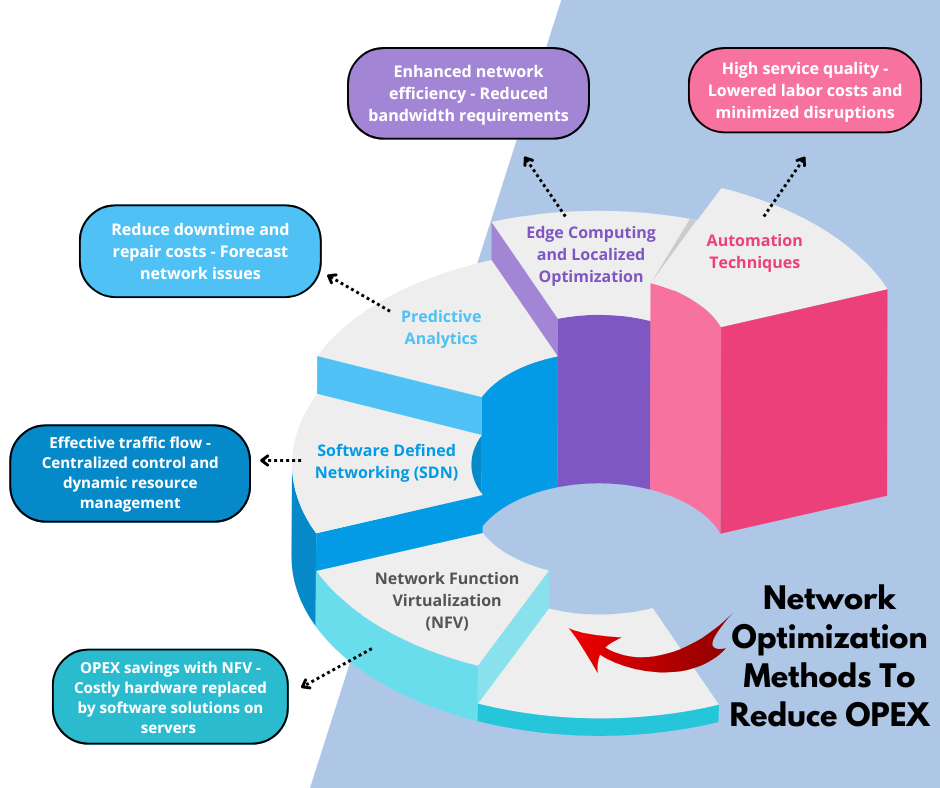The telecom industry is vital in global communication, facilitating real-time information transfer over vast distances. It streamlines the process flow of various sectors such as finance, healthcare, education, and entertainment. As per Invest India (March 2024), with a subscriber base of 1.091 billion, the telecom industry is the second largest.
However, this sector faces challenges with increased OPEX due to its susceptibility to technological and economic changes. Due to the rising operations costs, telecom operators are facing the pressure to provide quality services while maintaining operational efficiency. An effective strategy for achieving this balance is network optimization.
A company’s ongoing operations come with the necessary operational expenditures (OPEX) to ensure smooth functioning.
In telecommunications, OPEX covers expenses like network maintenance to ensure the efficiency of services provided. Telecom companies face challenges such as maintaining vast infrastructure and ensuring energy efficiency due to rising operational costs. These pressures make Operational Expenditure (OPEX) reduction a critical objective.
Managing OPEX effectively is crucial for telecom companies as it enhances profitability and allocates resources for innovation. Efficient OPEX handling aids in company expansion and improves customer service quality.
Network optimization comprises different techniques that improve performance and reliability. It’s not a one-time operation but an ongoing process. Underutilized network security operations negatively impact performance and leave systems unprotected. The sudden surge in traffic can overwhelm essential network functions and slow response times.
Business requirements require a certain level of performance, but time and budget often limit what it can tweak. So, the best way is to optimize within those constraints and monitor the network for the desired level of performance.
The following parameters are considered to show the network performance clearly. Here are five essential factors to target the most relevant areas –
The time required for data to travel between two locations; lower latency would mean a faster and more responsive network.
The percentage of data packets lost during transmission; increased packet loss indicates more significant network issues.
It refers to the inconsistency in latency across the network; high jitter affects real-time communication.
The percentage of network components used; more than 70% of usage will lead to delayed responses.
How often the network functions appropriately; optimal availability will minimize downtime.

The NFV technique virtualizes network functions traditionally carried out using patented hardware. By substituting specialized hardware with software-based solutions running on servers, NFV contributes to operational cost savings.
The SDN approach enables centralized control and dynamic resource management. This allows network administrators to manage traffic flow effectively and reduces expensive hardware upgrades. As a result, there is a significant decrease in OPEX by lowering maintenance costs and using existing infrastructure. Additionally, SDN ensures quick service and adjustments, further minimizing operational expenses.
The integration of predictive analytics helps telecom companies manage their networks effectively. Historical data analysis allows predictive models to forecast potential network issues.
This proactive approach reduces downtime and repair costs, enabling maintenance teams to address problems in advance. This not only reduces OPEX but also ensures a reliable network. Additionally, it enhances resource allocation, allowing telecom companies to deploy their maintenance teams effectively.
Businesses can implement self-healing networks and Robotic Process Automation (RPA) to reduce OPEX and enhance efficiency. RPA automates configuration updates and performance monitoring tasks, reducing labor costs.
Apart from this, self-healing networks autonomously detect and rectify faults. During a failure, a self-healing network initiates repairs and minimizes disruptions, creating a robust and cost-effective network system. This enables telecom companies to maintain high service quality while significantly lowering OPEX.
Edge computing and localized content delivery transform network efficiency through telecom sector data optimization. Decentralizing data processing and bringing it closer to the data generation source reduces the load on central networks. This localized processing minimizes latency and cuts down on expensive bandwidth requirements.
Additionally, Content Delivery Networks (CDNs) and edge servers cache frequently- accessed content closer to end-users. This approach reduces the need for long-distance data transfers. By storing popular content locally, telecom companies can ensure faster content delivery. Edge computing and localized content delivery reduce OPEX, making them essential modern telecom network management strategies.

Optimization of the network enhances return on investment by improving operational efficiencies. The use of AI can prevent failures and network outages. This approach not only reduces repair costs but also extends the lifespan of network equipment, increasing ROI. Optimized networks can also handle higher traffic volumes, driving more revenue from the same infrastructure.
Optimized networks directly contribute to superior customer experiences. Telecom companies can provide reliable services by ensuring faster data speeds and minimal downtime. Customers benefit from seamless connectivity, whether streaming videos or using smart devices. This improved service quality leads to higher customer satisfaction and retention rates. Moreover, telecom operators can swiftly resolve issues with advanced data optimization techniques, enhancing overall user trust and loyalty.
Optimization of network facilitates scalable infrastructure that can grow with increasing demand without a significant proportional cost rise. Virtualization allows telecom companies to allocate resources based on real-time needs, ensuring efficient use of network capacity. This flexibility enables seamless scaling during peak usage without over-provisioning, thus avoiding expenses.
Furthermore, optimized networks are better equipped to integrate emerging technologies like 5G and IoT. This enables companies to expand their offerings and enter new markets with minimal investment.
Optimized networks deliver enhanced performance and improved reliability. Data is routed through efficient paths, avoiding bottlenecks. Data optimization techniques like edge computing enhance response times and overall performance. Additionally, continuous monitoring ensures network operation at peak efficiency, adjusting to changing conditions and demands. This boosts the overall productivity and contributes to better user experience and satisfaction.
Network optimization offers many strategies to significantly reduce OPEX in the telecom sector. The benefits of leveraging AI for network management and predictive maintenance and utilizing SDN and NFV techniques are highly impactful. These optimization strategies not only aid in cutting costs but also provide a competitive edge in an evolving industry. Embracing continuous improvement and emerging technologies ensures telecom operators can navigate future challenges and seize new opportunities.